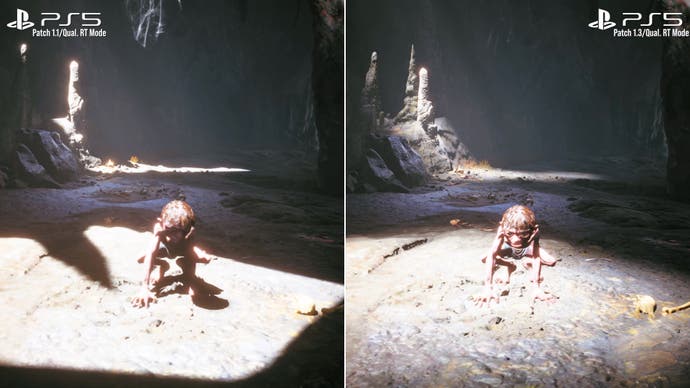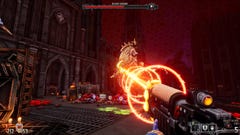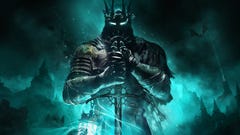The Lord of the Rings: Gollum - one does not simply expect technical competence
PS5, Series X and Series S tested.
I think it's fair to say that The Lord of the Rings: Gollum captured the headlines for all the wrong reasons on its debut with bugs, performance issues, an erratic camera and unreliable controls. Now on its latest 1.3 patch, I'm finally able to test the game on PlayStation 5, Xbox Series X and Xbox Series S - but even with the extra attention, I haven't played a game in such a dire state for a tech review for a long time. At least not since Shadow of Mordor way back in 2014 on PS3, an infamous porting disaster.
Gollum is fundamentally flawed in ways that go way beyond its frame-rate, which isn't great. The game design is almost taken straight from the dark ages of PS2 movie license tie-ins - an era where movie franchises were invariably turned into 3D platformers with awkward controls, a disastrous camera, and in the worst cases, bugs, bugs and more bugs. Given that, the £50/$60 price is inexcusable - but there's still some interest to be found in examining exactly what's gone wrong here.
Daedelic Entertainment first announced Gollum in 2019 - an Unreal Engine project with some interesting ideas - a mixture of stealth, 3D platforming and a good versus evil judgement system. For the stealth sections you use shadows and bushes to crawl past enemy orcs, while in platforming bits you navigate caves by clambering up walls, often with mundane goals like pillaging ID tags from dead orcs. Beyond its technical failings, which we'll get onto shortly, the biggest gameplay issue is in terms of its visual design. It's often difficult to see where to go next in murky caves, to judge whether a nearby wall is climbable or whether it'll lead to Gollum plummeting to their doom.
Booting the game up on PS5 and Series X provides us with the choice of three modes, with performance mode enabled by default, with quality and quality RT options alongside. All modes run with the same core visual settings and target 60fps, with the key difference being the resolution target.
On performance mode for example, Gollum runs with a 1440p target on PS5 and Series X, but uses dynamic resolution scaling (DRS) which drops the pixel count to around 1080p. Next along is the quality mode, which instead runs at a fixed 1440p, trading frame-rate for image quality. Quality RT re-engages DRS to make up for the added GPU strain of ray tracing, with the 1440p target often dropping to 1260p.
Jumping over to Series S, we get two modes, performance and quality - no RT here. Otherwise, Series S is a feature match for the premium consoles, even down to the resolution. There's a dynamic 1440p on its performance mode, again going down to 1080p lowest and then a fixed 1440p on the quality mode, just like PS5 and Series X. The catch is that gameplay is capped at 30fps on Series S regardless of mode.

Most curious of all of the options on console is the RT mode on PS5 and Series X. The team at Daedelic includes RT shadows and RT reflections on PC, but it's reflections only for PS5 and Series X - and these reflections are selectively applied to the level too. Around Gollum's cave for example, there's a crisp mirror image on water bodies like puddles, which genuinely looks superb. The opening cave area is a great RT showcase with its dewy wet surfaces. The drawback is that most puddles across the level aren't ray-traced, and instead revert to a screen-space or cube-mapped method, so it's a mixed result. Where ray tracing does appear, the results are impressive, even if you pay a performance penalty for it. In general though, most scenes are identical in their visual make-up regardless of mode.
There's an extra twist to this RT mode. Before the latest 1.3 patch, I captured the game on patch 1.1 on PS5, which many journalists used for review. Gollum's frame-rate with RT enabled was significantly worse in this version - running as low as 15fps in this cave section - because the mode ran with ray-traced shadows as well. Before launch, this was easily the standout visual flourish on console. Version 1.1 also featured enhanced water shaders, adding a diffuse layer to RT reflections. Clearly though, those extra visual features were jettisoned to shore up the frame-rate. There's PS5 footage of this 'lost mode' in the embedded video above if you want to see how it looked.
Enter patch 1.3, which massively improves frame-rates using the quality RT mode. In one spot in the cave, I measured 15-20fps before the patch and 30-40fps after. However, as well as losing out on some visual niceties, Gollum also escapes his shadow entirely - he goes completely unshaded in a lit spot, with even basic shadow maps not being applied. Thankfully, later areas are unaffected by this bug, and I'd probably still take the higher frame-rate regardless - even at the expense of the RT shadows and water shaders that made the console versions look much better.

Another feature removal is a toggle for Gollum's hair physics, which in patch 1.1 prompted huge numbers of crashes when enabled on PS5 - about a dozen crashes in the first 30 minutes of play during my testing. The funny thing is, it's really such a minute detail, letting these damp clumps of hair on Gollum's scalp flap around. The option is still available on both Xbox Series consoles as of version 1.3 and actually has a very minor performance impact overall. I wouldn't be surprised if this feature returns for PS5 once the cause of the crashes can be identified and fixed, but for now Xbox players get a small visual advantage.
Before we get to the frame-rate, let's talk bugs - of which there are many, even on the latest patches available to each system. Perhaps the most glaring issue is on Xbox Series X and S, where both camera and animations suffer from additional judder not seen on PS5. Camera motion updates at uneven intervals on Xbox, creating an erratic, choppy result that is worsened at low frame-rates. In extreme cases, like the Series S quality mode for example, the camera no longer updates at typical intervals and panning motions become uneven. The bug affects Gollum's jumping animations in a similar way. Any time the frame-rate is sub-30fps, rapid movements from Gollum update at almost half intervals, making the action practically impossible to track by eye. As it stands Xbox is behind in the patch updates compared to PS5, but hopefully this one will be addressed quickly because it affects playability quite significantly.
Moving on, there are other issues. I've had gameplay load after a cutscene with no geometry or collision meshes, leading to Gollum falling to the bottom of the level, reloading, and the same bug occuring to repeat the cycle. I eventually had to delete my PS5 save and start all over again.
Outside of game-breaking bugs, textures and materials sometimes appear to be exceptionally low quality, almost as if using placeholder assets, with higher-quality materials not loading in even after waiting. I also encountered awkward NPC walking animations, broken collision detection that leads to Gollum floating over jumpable partitions, and controls that simply stopped responding altogether, requiring a game restart to fix. I'm only scratching the surface here, but Gollum needs a lot of work in tackling all of its bugs.


PS5 performance sees the default performance mode runs reasonably well based on the first three chapters - typically 45-60fps, with a bulk of play at 60fps in the opening cave section. Unfortunately, you do have to contend with a forced 30fps cap during cutscenes. Even on performance mode, the low frame-rate and uneven frame-pacing adds additional judder to movement. Switching to Series X, frame-rates are a bit less impressive - 40-60fps - and more importantly the console suffers from big streaming hitches not seen on PS5. Just running through the opening missions, you'll get big frame-time hitches in excess of 100ms, and sometimes several in sequence. It happens out of the blue, but especially in transitions to and from cut-scenes which sticks out like a sore thumb.
Unfortunately, performance mode is the best case scenario here and comes at a significant cost to image detail. To solve this, you can opt for quality mode but this drags performance in the opening cave section to around 40fps on Series X and the high 30s on PS5. It's not great and for both consoles the higher-resolution quality mode tends to waver between 35 and 50fps. More glaring is the state of in-engine cutscenes, which now run into the teens. That makes quality mode a very tough sell on both PS5 and Series X.
There's also the quality ray tracing mode, which predictably runs even worse in spots that feature RT reflections - despite its lower resolution. On PS5, the opening cave areas run in the 30-35fps range, while Series X runs at around 35fps in the same section. Fortunately, the addition of dynamic resolution scaling on both machines gives the renderer some flexibility and later levels with fewer RT reflections tend to run better overall, even approaching the maximum 60fps. On both PS5 and Series X it makes for a sluggish experience in parts. It's worth seeing in action when those RT reflections do show up, but for general playability the performance mode is easily the best pick.

We haven't forgotten Series S, which takes performance to heretofore unseen levels. Starting with the so-called performance mode (which maxes out at 30fps), there are regular drops into the 20s even with DRS engaged and we get the same streaming hitches as the Series X version. Expect big lurches in frame-times without obvious cause, so good luck timing your jumps. In cutscenes, in performance mode I remind you, Series S drops into the low teens. There's really nothing performant about this mode, but I dread to think what other visual sacrifices would be necessary to bring the game just to a locked 30fps.
Quality mode is the other option on the junior Xbox and this is easily the worst way to play Gollum on current-gen consoles. I'm not sure why it's included. At a fixed 1440p, Series S runs at 20-25fps through the whole opening cave section, with the erratic camera and animation refresh bug making the game practically unplayable at points. All movement is simply out of sync with the frames being rendered, even at 20fps. Even later sections don't improve as we work our way into the lava-filled mines or the prison camps. I'm all in favour of having more options, but as it stands this mode is one to avoid for Series S users.


Overall, it's easy to count the shortcomings of Lord of the Rings: Gollum. The glaring lack of polish in its visuals at launch, the game-breaking bugs, the sub-par performance - it's hard to overlook given the high price-tag of the digital game. There are at least elements of Gollum that might interest LOTR fans, filling in a blank chapter of the story between The Hobbit and The Lord of the Rings. In fact, the concept art included in the deluxe edition does give a fascinating insight into what could have been - and why there was excitement about the project back in 2019. But fundamentally, Gollum hasn't landed as it should and it has core issues that even a litany of patches may not solve.
It's telling that the high point for Gollum, visually speaking, is seeing those ray-traced shadows - a beautiful feature that's sadly been scrapped on PS5 and Series X, at least for the time being. Even with that highlight removed, Gollum's performance on the most powerful consoles on the market still isn't enough. Beyond patch 1.3, the update forecast will be interesting to track, to see to what extent the developer is able to turn Gollum's fortunes around. In the meantime though, as a stealth game Gollum is more worm eater than Snake Eater, and without doubt, one to avoid.
















